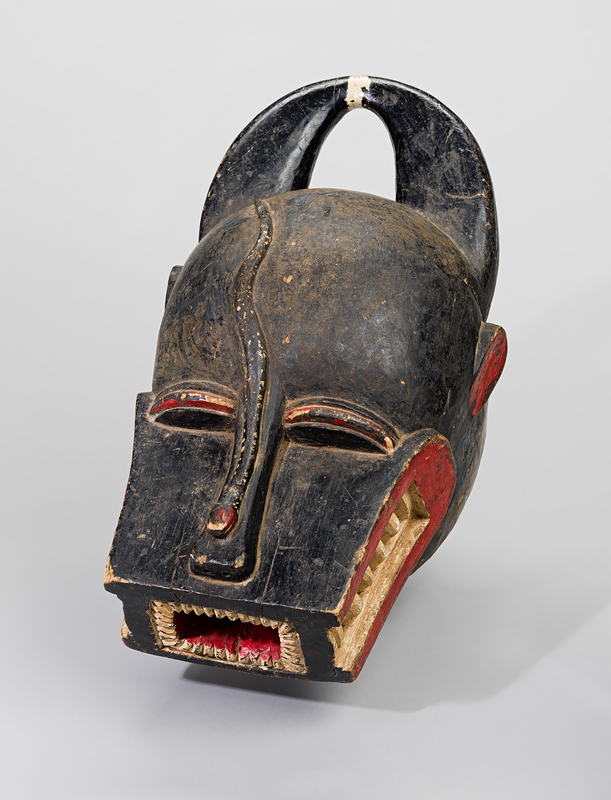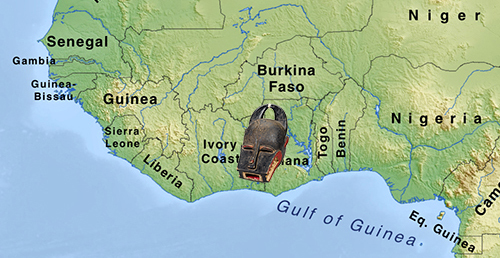Catalogue 28
Helmet Mask, bonu amuin
Baule and Guro people, Côte d'Ivoire
Wood and pigment; 17 3/4 x 9 5/8 x 7 3/4 inches (45 x 24.4 x 19.7 cm)
Smithsonian Institution, Department of Anthropology
Gift of Allen and Barbara Davis
E435357
The Baule belong to the larger group of Akan peoples and today live primarily in the Ivory Coast. Their oral traditions state that around three hundred years ago they migrated westward from Ghana when the Asante rose to power. Unlike the Asante, the Baule have a long tradition of masquerades. Some of their masks, like this helmet mask, are ritual masks and are sacred, while others are created primarily for entertainment.
Ritual masks belong to the village men’s association and embody powerful bush spirits. They are called bonu amuin, “gods in the bush,” or amuin yasua, “men’s gods.” The masks resemble the forest bush buffalo (Syncerus caffer nanus) with its characteristic broad and thick horns curving backwards from the head, although the Baule do not recognize them as any specific animal but rather as a powerful spirit. This particular mask, carved from one piece of wood with its squared maw and rows of teeth, is a prototypical example of a bonu amuin mask that speaks forcefully to this power.
These masks are kept in a sanctuary in the sacred wood, and men who have direct roles in the ceremony attend the mask and activate it through a sacrifice. The mask dance itself can be witnessed by all men who have completed a small private ceremony that includes an offering of palm wine or a chicken to the spirit. When the mask enters the village at night it is accompanied by the vibrato sounds of a bull-roarer or a two-membrane drum that announces the spirit’s presence. Men describe these sounds as the spirits’ voices. The masker appears in a costume of woven raffia or bark strips and carries a whip and lance. Women and children are forbidden from seeing these masks and are required to remain in their houses when the spirits are abroad.
Spirit masks are danced to protect the community from outside threats such as witchcraft, disease, and warfare. The mask attends the preparation of the corpse, and later, at the end of the mourning period, appears in order to banish death from the community. With changes over the past several decades, the spirit masks have come out at dry-season festivals and at commemorations following the death of former dancers and important men. Since the 1960s conversions to Christianity have gradually devitalized the men’s associations, which have attracted fewer and fewer members. The masks are danced less and less frequently, and they now show a certain deference to civil authorities. They are described by elders as more tamed and have lost much of their power and prestige in the community.
MJA
References
Boyer, Alain-Michel. 2008. Baule. Milan: 5 Continents Editions.
Vogel, Susan M. 1997. Baule: African Art, Western Eyes. New Haven: Yale University Press.


